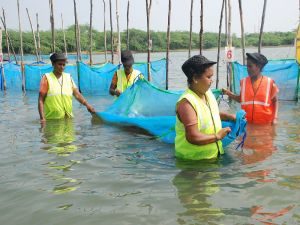
Women in Lake Pulicat building crab fattening cages. Photo: Dr. B. Shanthi, CIBA (ICAR), India.
A tremendous emphasis in agriculture, fisheries and aquaculture research is given to developing new, more efficient and profitable technologies for farmers and fishers. Governments all around the world support research and extension institutes, and the private sector also has a huge influence. But how are women faring in having a say in what their priorities are and in getting access to the innovations? Most especially in the agriculture sector, a considerable amount of research has gone into evaluating these questions. Catherine Ragasa and Debdatta Sengupta from IFPRI, and Martha Osorio, Nora OurabahHaddad, and Kirsten Mathieson from FAO recently reviewed what has been learned. Their report – Gender-specific approaches, rural institutions and technological innovations: Identifying demand- and supply-side constraints and opportunities in access, adoption and impact of agricultural technological innovations – is well worth reading. It puts together key findings and good recommendations for integrated and stand-alone action. The integrated actions are particularly important as they stitch together the issues of gender and technology needs, its generation, and its dissemination. In the process, they weave together the central importance of gender in the workforces of research and extension institutions.
Here are key messages
- Female heads of households and plot-managers are less likely to adopt a wide range of agricultural and rural technologies than male heads and plot-managers. The most commonly-cited reasons are greater time and labor constraints; relatively less access to funds and credit; more limited information, education and training; more limited capacity and opportunity for participation in innovation and decision-making processes; and more limited access to accompanying inputs and services. These are influenced by weak legislation that protect rights and promotes equality and by persistent social biases and cultural norms.
- Although various labor-saving and energy-saving technologies have huge potential, empirical studies show that their use and adoption among rural women is often low and usually much lower than men. Three reasons for gender differences are common: (1) cultural-appropriateness; (2) physical accessibility; and (3) affordability. In some cases, the adoption of improved productivity-enhancing technologies has increased women’s time burdens. The most common reason is the weaker participation and engagement of women farmers and stakeholders than men in priority-setting and research processes, limiting the opportunity to influence the development of new technologies.
- In ICT, men are more likely to use the Internet and to have an email address than women. There is a more promising pattern of rural women accessing and using radios for agricultural information, although men still are more likely to own and control their use. The gap between men’s and women’s access use of mobile phones is diminishing, although in rural areas, men are more likely to own and have access to phones than women, who have greater levels of illiteracy, cultural barriers, and less available cash and access to credit.
- There is increasing attention in the literature that women and men farmers are innovators and doing their own farm experimentation. Innovation funds can provide incentives for farm experimentation for women and men. Rural institutions and innovative producer organizations can succeed in using collective action to address access and liquidity and to reduce gender gaps in technology adoption. Farmer-innovators benefit more if they are linked with research and extension institutes, a conducive rural business climate and are linked to lucrative markets.
- Most support organizations, including research organizations and their staff have weak capacity and incentives to be more effective and responsive to the needs of both women and men farmers. Numerous attempts of participatory and consultative approaches failed to deliver significant broad-based impact on technology adoption and gender-equitable outcomes. But, women are overwhelmingly under-represented as scientists, educators, graduates, managers and extension agents. Initiatives to increase more women graduates, scientists and extension agents are being implemented, but more need to be done.
Recommendations (in summary)
o Strengthening capacity of women and men farmers as innovators, evaluators of technologies, and key partners in innovation processes.
o Build measurable targets and strengthening the monitoring and evaluation to ensure that (1) planning and innovation processes addresses women and men’s needs, preferences and opportunities; (2) women and men can access and use these technologies; and (3) women and men benefit from these technologies.
o Holistic and integrated approach of looking at constraints to production and marketing and paying close attention to the complementarities of inputs and services.
o Promoting equal playing field: strengthen women’s land, property and water rights. Affirmative action to ensure that more girls are going to school and more women professionals are getting equal opportunities as men in the area of research, extension, and education systems. Quota systems, focal points, and gender-balanced staffing in research, extension and education organizations do not often work without genuine empowerment among women professionals including confidence-building, greater mobility, decreasing time burden, training and capacity strengthening.
o More attention in research to gender-disaggregated data and gender analysis in mainstream research is needed. More studies are needed that provide nuanced categorization and analysis on gender and addresses the diversity and typologies of women and men farmers.
Download the report.
This entry was posted in: Aquaculture, Gender, Marine Fisheries, Men, Women
